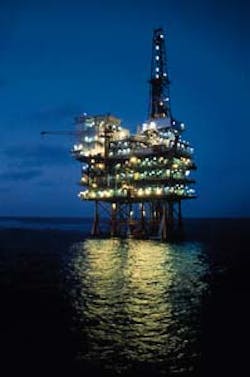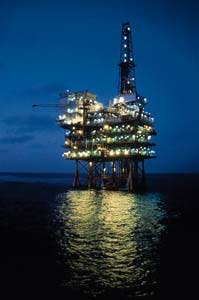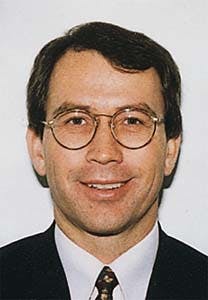Remote South China Sea reservoir prompts extended reach record
Kelly Talkington
Phillips China Inc.
Shekou
The Xijiang 24-3 platform drilled a record 5-mile long, extended-reach well in order to target a remote reservoir. Teamwork, rig upgrades, experience, and technology overcame an otherwise uneconomical project. As of June 10, 1997, the well flowed 7,000 bo/d (Fig. 4).Platform rig upgrades, technology, and teamwork enabled Phillips China Inc. (PCI) to drill a world-record, extended-reach well (ERW) in the Pearl River Mouth basin of the South China Sea.
Extended-reach drilling (ERD) provided the only cost-effective way to develop the relatively small and remote Xijiang 24-1 field. The Xijiang 24-3 A14 well was drilled to a measured depth (MD) of 30,308 ft (9,238 m) and a true vertical depth (TVD) of 9,793 ft (2,985 m), achieving a world-record horizontal displacement of 26,453 ft (8,063 m; ) (Fig. 1 [153,805 bytes]).
The well was completed on June 10, 1997, and was flowing 7,000 bo/d and 3% bs&w with a flowing-tubing pressure of 390 psi on Oct. 1, 1997.
PCI discovered the Xijiang 24-1 field in 1985 with the 24-1-1x (Fig. 2 [166,932 bytes]), the only well drilled in the field. This well encountered 43 m of net pay from 14 separate sands, predominantly in the Hanjiang formation (Fig. 3 [18,133 bytes]). During drill stem tests, this well tested at a cumulative rate of 12,470 st-tk b/d with virtually no gas. After testing, the discovery well was permanently abandoned.
The sands, all normally pressured, exhibited high flow capacities and permeabilities greater than 10 darcies. Reserves estimates, however, were small. Subsequent field studies indicated that water injection for reservoir maintenance would be required. These studies also concluded that the low bottom-hole pressures and the potential of early water breakthrough would require electrical submersible pumps (ESPs) for production.
Because of the small reserve estimates, costs, and complexity of water injection, the development of 24-1 seemed unlikely.
With further exploratory and appraisal drilling in the South China Sea, PCI discovered and later developed the Xijiang 24-3 and 30-2 fields. These fields are located approximately 85 miles southeast of Hong Kong. Two platforms, both with drilling and production facilities were installed in 1994 and 1995 for the joint development of these fields.
During the development design-phase, attempts were made to include the Xijiang 24-1 in the joint development; however, the small volume of reserves would not justify another platform. At that time, drilling an extended-reach well (ERW) from the Xijiang 24-3 platform, located approximately 5 miles away, was considered unachievable.
In late 1995, PCI took one last look at potentially developing the Xijiang 24-1. The success of ERW drilling, particularly in the North Sea, provided support for a successful ERW development.
In addition, production histories from equivalent sands in the Xijiang 24-3 and 30-2 fields indicated that Xijiang 24-1 would have moderately strong aquifer support, meaning that additional water-injection wells would not be required. However, an ERW of this class drilled into a reservoir as small as the Xijiang 24-1 had never been attempted by any operator using an upgraded platform rig.
In early 1996, a project team including experienced ERW drilling personnel from the North Sea determined the feasibility of drilling an ERW from the Xijiang 24-3 platform (Fig. 4 [9,830 bytes]). The concerns addressed by this team included:
- The rig's drilling capability-The Xijiang 24-3 platform drilling rig was only designed to drill to up to 15,000 ft MD (10,000 ft TVD). It was uncertain whether the rig could be upgraded to drill such a well and was the biggest concern of the project.
- The lack of ERW drilling experience in the area-No world-class ERD had taken place in the South China Sea.
- The relatively remote location of the Xijiang operation-Most ERD has taken place in the North Sea, and high-technology ERD tools, including back-ups and spares, would have to be imported into China.
- The transitional step from drilling relatively shallow-development wells to setting a horizontal-displacement world record-Prior to Xijiang A14, the deepest well drilled by the Xijiang 24-3 drilling rig was 9,100 ft MD.
- Hole stability problems-At least three different hole-stability models were run on the well. Only one provided evidence that the well could be drilled.
- Geologic uncertainty-The geology at the Xijiang 24-3 was well understood, but the geology of the Xijiang 24-1-1x closure and the area between was less well documented.
- Torque and drag considerations-Both normally increase with increasing horizontal displacement.
- Directional control-Targeting a small reservoir would require measurement-while-drilling (MWD) tools and inclination and azimuthal control. The target size was a circular area with a diameter of 500 ft.
- Weather-During the typhoon season between June 1 and mid-October, it is necessary to demobilize all platform personnel prior to the approach of a typhoon.
Prior rig modifications
The Xijiang 24-3 rig was originally built in 1987 for an offshore California development project. The rig was never used, and PCI purchased it in 1992 for the Xijiang project. At that time, it was extensively upgraded in order to drill 12 development wells. The rig, as upgraded for the Xijiang 24-3 field development included the following equipment:
- A derrick rated at 1 million lb with a racking capacity for 15,000 ft of 5-in. drill pipe
- Two 1,600-hp mud pumps with 5,000-psi fluid ends
- High-pressure mud lines rated at 5,000 psi
- A power swivel (top drive) rated at a continuous torque of 43,000 ft-lb rotating at 100 rpm
- Two linear-motion shale shakers, one desander, one desilter, and one centrifuge
- Liquid storage capacity of 1,400 bbl
- A pipe deck with a storage area of 5,325 sq ft.
ERW modifications
Even with the modifications for the Xijiang 24-3 field development, further upgrades were necessary in order to drill the ERW:- The derrick rating was increased to 1.5 million lb with the installation of additional structural members including steel beams and girders.
- The derrick's racking board was changed out in order to handle 23,000 ft of 51/2-in. drill pipe.
- Pump capacity was increased with the addition of a third 1,600-hp mud pump obtained from the Xijiang 30-2 platform.
- The 5,000-psi fluid ends were changed to 7,500-psi fluid ends for all three mud pumps.
- One temporary 7,500-psi, high-pressure mud line was installed from the mud pumps to the rig floor, including the addition of one standpipe.
- Three additional shale shakers and a second centrifuge, also obtained from the Xijiang 30-2 platform, were added. Mud-return piping was modified to remove the desander and desilter from the flow path.
- Liquid-mud storage capacity was increased by converting a 1,000 bbl water storage tank to an oil-based mud (OBM) storage tank. In addition, 500 bbl OBM mixing tanks were installed on the skid deck and a 2,000 bbl OBM supply vessel was hired.
- The power swivel used to drill all of the Xijiang 24-3 and 30-2 wells was upgraded. The gear ratio was changed to provide 51,000 ft-lb of continuous torque while rotating at 100 rpm. An extensive overhaul of the power swivel was also performed.
The upgrades began September 1996 and were completed in February 1997. Excluding the overhaul/upgrade of the power swivel, all of the modifications were conducted offshore by the rig crews. The total upgrade cost was approximately $6.5 million.
The well
To supplement the lack of local ERW drilling experience, experts from Phillips Petroleum Co.'s North Sea divisions, as well as engineers from Cnooc and Pecten provided assistance on the project.To ensure the best possible chance of success, service company selections were based on the quality of tools and service, not on the lowest bid. Emphasis was placed on building a solid, experienced team and providing them with the best tools on the market.
The well design for for Xijiang A14 was similar to other Xijiang wells but with longer casing strings. Well designs for all of the Xijiang 24-3 and 30-2 wells consisted of:
- 24 in. conductor casing, preset during the installation of the platform and driven to 672 ft
- A 16-in. hole drilled with seawater
- 133/8-in. surface casing set at 1,640 ft
- 121/4-in. hole drilled with 8.8 ppg water-based polymer mud
- 95/8-in. production casing set at TD; two of the Xijiang 24-3 horizontal wells included prepacked screen liners
- 41/2 in. completion tubing. The well plan for Xijiang A14 consisted of (Fig. 5 [91,268 bytes]):
- 24-in. conductor casing (existing string)
- 22-in. hole drilled with seawater
- 185/8-in. surface casing set at 1,305 ft
- 16-in. hole drilled with 8.8 ppg water based polymer mud
- 133/8-in. intermediate casing set at 5,668 ft
- 121/4-in. hole drilled with 8.8-9.3 ppg low-toxic mineral OBM, the first time OBM was used at Xijiang
- 95/8-in. production casing set between 20,000 and 23,000 ft
- 81/2-in. hole drilled with 9.3 ppg low-toxic mineral OBM
- A 7-in. liner set at TD
- 41/2-in. tubing completion
- Electric submersible pump.
Drilling program
The rig was upgraded and the well drilled in two phases. Phase I drilling included setting 185/8-in. and 133/8-in. casing strings. Phase II drilling included setting 95/8-in. casing and a 7-in. liner, and completing the well.Drilling in two phases provided the opportunity to test-run some of the equipment prior to drilling the extended-reach sections. In addition, setting the casing strings early instead of waiting for all upgrades to be completed increased the chances of completing the well prior to the start of typhoon season.
Upgrades for Phase I consisted of those items that did not include long-lead delivery equipment. This included the installation of the mud pump and solids-control equipment from the Xijiang 30-2.
Phase I drilling commenced Nov. 22, 1996, and took 10 days to finish. A 22-in. vertical hole was drilled to 1,315 ft followed by running and cementing the 185/8-in. casing. Next, a 16-in. hole was drilled to 5,678 ft.
The well was directionally kicked off at 1,430 ft, and the hole inclination was built at 3?/100 ft until a tangent angle of 80? was attained. An additional 325 ft of hole was drilled at this angle until casing point was reached. No special tools outside those needed for drilling normal development wells were used during this phase.
Phase II
Phase II drilling commenced on Mar. 11, 1997. A 121/4-in. hole was drilled to 22,173 ft, maintaining the tangential inclination and azimuth as built in the 16-in. hole. The bottom hole assembly (BHA) included MWD and logging-while-drilling (LWD) tools.The LWD tool consisted of gamma ray and resistivity tools. In addition, an adjustable stabilizer was run behind a steerable downhole motor. The blade diameter on the adjustable stabilizer was remotely adjusted in order to control inclination while in the rotary mode.
The adjustable stabilizer saved on the number of trips which otherwise would have been necessary to change out the BHA for directional control purposes.
The section was drilled with 51/2-in. drill pipe with high-torque connections. Nonrotating drill pipe protectors (Nrdpp) were used to reduce torque. A total of six tricone and polycrystalline diamond compact (PDC) bits were used in this section. Geosteering tools were made available but were not used in this hole section.
The initial project group concluded that high-accuracy gyroscopic tools would be required for defining the directional course of the well. It was believed that MWD tools would not provide the accuracy required to hit the target. The actual surveys obtained from a gyroscope run to 14,646 ft, however, nearly matched those obtained from the MWD. From this point on, no further gyroscopic checks were taken.
A sidetrack was required during the 121/4-in. section after the drillstring became stuck during a wiper trip at 16,918 ft, probably caused by stressed shale. To overcome the problem, more-frequent wiper trips in the sidetrack were made until casing point was successfully reached. No further sticking problems were encountered.
After drilling to casing point, the 95/8-in. casing was run and cemented at the desired depth. To assist in reaching bottom, a floatation collar was installed in addition to roller-blade centralizers (RBCs). The floatation collar enabled the bottom of the casing string to be floated-in.
The casing was run into the hole empty until the floatation collar was installed. After that, the casing was filled with heavy mud to help push the casing into the hole. One RBC was run for every joint in the open hole. The final string weight, excluding the blocks and power swivel, was 35,000 lb. The casing was cemented with no returns.
The BHA for the 81/2-in. hole section was similar to that in the previous section. It included MWD and LWD tools as well as an adjustable stabilizer and a steerable downhole motor. For the final BHA, a density/neutron tool was added to the LWD tools in order to record porosity data across the reservoir.
A combination of 51/2-in. and 5-in. drill pipe was used to drill this section. Nrdpps were again run to reduce torque. The maximum rotating torque of 33,000-41,000 ft-lb occurred during the last bit run.
The 81/2-in. hole section was drilled to TD with two PDC bits. Hole angle in this section was maintained at approximately 80? until approximately 26,250 ft. At this depth, the inclination was gradually dropped. In order to do so it was necessary to reconfigure the BHA, the adjustable stabilizer, and other drilling parameters.
The drop in inclination was necessary to encounter all hydrocarbon-bearing sands. If the inclination was not reduced, the well bore would have missed several sands located at the base of the Hanjiang formation (Fig. 3). The hole angle at TD was 54?.
After making up the liner hanger and packer assemblies, the liner was run in the hole on 51/2-in. drill pipe.
With the shoe positioned at 27,096 ft, it became necessary to push the casing down using the power swivel. With the shoe at 28,064 ft, approximately 2,227 ft from the desired setting depth, no further progress could be made. This occurred in the section where the well inclination was dropped from the tangent angle, despite low dogleg severity. An attempt was made to rotate the pipe using up to 36,000 ft-lb with no success.
The hanger was then set at 19,595 ft with the liner shoe at 28,051 ft. The liner was cemented with full returns and then the hanger packer was set.
The liner was cleaned out using a 6-in. PDC bit, a 43/4-in. motor, and a combination of 31/2-in. and 51/2-in. drill pipe. The shoe track was drilled out and the hole cleaned to a depth of 30,012 ft. Using a cement stinger on 31/2-in./51/2-in. drill pipe, a cement plug was placed from 29,848 ft to 29,392 ft, covering the oil/water contact at the bottom producing formation.
The cased intervals were perforated using a 41/8-in., pressure-activated, tubing-conveyed perforating gun. The well was then completed with 41/2-in. tubing with the bottom intervals completed open hole. The only water contact observed in the completed open hole section was isolated with the cement plug mentioned above.
The initial completion did not include an ESP because of the expected aquifer support and little water production. Future plans for the well include the installation of an ESP when the water cut increases and the well comes off natural flow.
The total time on the well for both Phases I and II drilling operations was 101 days. The total cost to drill and complete was about $17 million.
The Author
Kelly Talkington is a well construction team leader for Phillips Petroleum Co. Norway in Stavanger. Since 1979, he has worked for Phillips in the U.S., Norway, U.K., and China. Talkington has a BS in petroleum engineering from the University of Oklahoma.
Copyright 1997 Oil & Gas Journal. All Rights Reserved.


